5 Promoting Community-Driven Change in Family and Community Systems to Support Girls’ Holistic Development in Senegal
Dr. Judi Aubel, Ph.D.
This case study takes a look at an innovative intergenerational approach to promoting girls’ rights and development in Senegal.
The Big Picture
This is the story of the Girls’ Holistic Development Program designed and implemented by the non-profit organization, Grandmother Project – Change through Culture, in Southern Senegal starting in 2010 and evaluated on several occasions by outside researchers. The case study describes this innovative program, the results, and the lessons learned that are relevant to other African contexts, and to other collectivist cultures in the Global South or Global North. This author is the co-founder and Executive Director of the Grandmother Project initiative.
The Grandmother Project’s Mission
…is to improve the health and well-being of women, children, and families
in countries in the Global South, by empowering communities to drive their own development
by building on their own experience, resources, and cultural realities.
Senegal Community Context
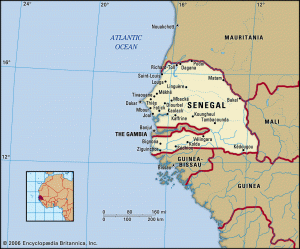
The American and Senegalese non-profit organization Grandmother Project – Change through Culture (GMP) works mainly in Senegal, on the west coast of Africa. GMP’s work is in southern Senegal, a rural area where farming and cattle raising are the main economic activities. This area is severely economically challenged and one of high migration of men to the capital city and in some cases to Europe. The quality of health services and of schools is generally poor. Only very young, inexperienced health workers and teachers tend to work in this area that is a 10-hour drive from the capital, Dakar. Only about 5% of all teachers in the area are women. Very few communities have electricity which makes evening studying very difficult even for very motivated students.
More than 95% of Senegalese people are Muslim. People’s lives are influenced by Muslim and African values that include respect for elders, solidarity, generosity, and interdependency. While western societies value individual rights and achievement, African cultures are built on collectivist, or relational, values and accord greater importance to interdependency and support of group values and achievement than to autonomy and individual accomplishment.
Like other African countries, in Senegal families and communities are organized hierarchically with men having more power and influence than women and with elders having authority over younger family members. The role of elders is to transmit cultural and religious values to younger generations. An often heard saying in Senegal, and across Africa, says, “What an elder can see sitting on the ground, a young person cannot see even if she/he is on the top of a tree”.

Intergenerational relationships were traditionally very strong, however, nowadays, in many cases, they are strained by a breakdown in communication between elders, parents, and children. The lives of Senegalese people are very much influenced by non-western, collectivist values, many of which differ markedly from those of western societies. In the Velingara area in Senegal where GMP is working, extended families predominate, and multi-generational decision-making and caregiving of younger family members are prevalent.
Growing up in this context is full of challenges, especially for girls. Some deep-seated social norms greatly limit their opportunities for growth and development. Most families prioritize boys’ education over that of girls, and early marriage of girls, sometimes as young as 12, is prevalent, often with families playing a major role in identifying a spouse for their young daughters. For girls who stay in school beyond puberty, teen pregnancy is another very problematic phenomenon.
Female genital mutilation (FGM) is practiced by some ethnic groups in Senegal. A study in 1988 by the Environmental Development Action in the Third World (ENDA) revealed that approximately 20 percent of the female population had undergone an FGM procedure (para. 2). Other estimates suggest the figure is between 5 and 20 percent. Among the Halpularen (Peul and Toucouleur) populations in rural areas of eastern and southern Senegal DHS statistics from 2017 indicate that 50% of women age 15 to 45 underwent the practice. These figures refer to the total population, not the Halpulotas practice.
Background of the Girls’ Holistic Development Program in Senegal
At the outset, the international non-profit organization World Vision asked the Grandmother’s Project to develop a strategy to specifically address female genital mutilation (FGM) in the Velingara area of Senegal. The World Vision Director told me (Dr. Aubel) that their earlier efforts discourage the practice using traditional health talks had not been effective and they wondered if involving the grandmothers participating in our programs might be a good way to address the issue. I (Dr. Aubel) told them that FGM is a very complex issue and that there are no simple strategies to promote the abandonment of this harmful practice and I proposed an initial Preparatory Phase composed of two activities to understand communities’ attitudes toward the practice, and then three additional components: Implementation and Learning Phase, Program Evaluation Phase, and Development of Lessons Learned for a total of four components. This process, was carried out over a 12-year period as an iterative action learning process.
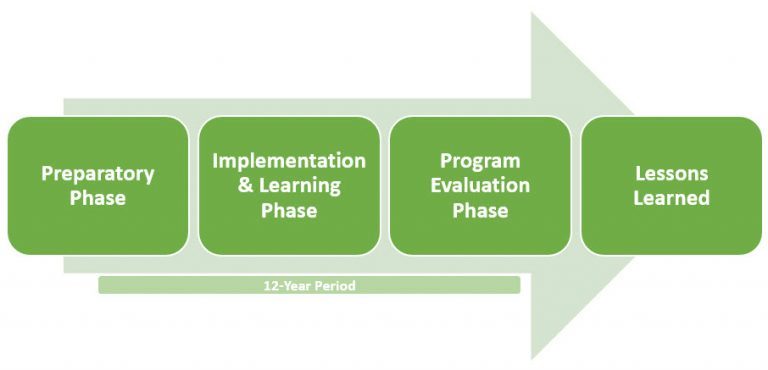
Preparatory Phase
To develop the Girls’ Holistic Development Program, the two initial activities under the proposed Preparatory Phrase were: a participatory and rapid qualitative assessment and a series of dialogue forums to discuss the results of the assessment with community actors.
Participatory and Rapid Qualitative Assessment
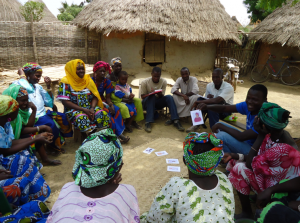
As it is important to foster an environment where community members are viewed as the experts of the situation in their own communities. The initial assessment sought to first, understand families’ priorities and concerns regarding girls’ education and upbringing; and second, to understand the attitudes, roles, and experiences of community members and of health and development workers related to FGM. This assessment was conducted by the author (Dr. Aubel) in conjunction with members of the Grandmother Project Team. A participatory approach was used consisting of small in-depth group interviews with traditional community male leaders, religious leaders, grandmothers, men, women, local authorities, health workers, and other Non-Government Organizations’ (NGO) staff working in the area.
The rapid qualitative assessment provided critical information on the attitudes of both community and health and development workers toward FGM. However, of greater significance was the information that revealed community members’ concerns regarding the education and upbringing of children, and specifically of girls. Three main themes emerged from the interview data related to families’ concerns regarding 1) the breakdown in communication between elders, parents, and children; 2) the resulting decrease in transmission of moral, cultural, and religious values and traditions to children, e.g. showing respect for elders and story-telling; and 3) families’ concerns regarding children’s attitudes and behavior that conflict with priority family and cultural values.
“We should go back to our roots. We need to recognize what is positive within our culture and hold on to it jealously.”
Demba, NGO community development worker
“If we lose our cultural values, we will be forced to replace them with other people’s values.”
Abdoulaye, Teacher
These insights into community members’ concerns regarding children’s education and development were critical in subsequently developing an intervention that would respond to their concerns while at the same time catalyze reflection on an issue that we viewed as a problem, but that they did not.
Series of Forum-Dialogues
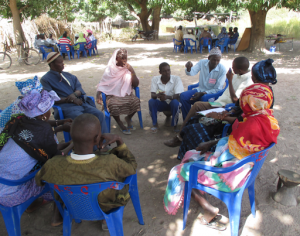
The second activity in the Preparatory Phase consisted of forum dialogues held in four communities. Each forum involved 25 participants, male and female elders and parents, many of whom were community leaders. The objectives of the forums were: to share the results of the community study; to elicit dialogue on how cultural values and traditions being lost could be revitalized in families and communities to ensure the development and well-being of children, and specifically of girls, and to identify strategies to promote discussion of FGM in communities. Based on participatory adult education principles, the team developed a training design for the forums to encourage open discussion related to these objectives recognizing that FGM had never before been discussed in a public setting.
In Africa, community resistance to many social programs is engendered by the fact that they are critical of and aim to change certain ingrained cultural norms and practices. A fundamental principle that shaped the forums and subsequently the entire GHD program, is the idea that programs that promote change in certain harmful traditions, e.g. FGM, should simultaneously promote positive cultural values and traditions.
A key idea that shaped the discussions during these initial forums was a profound statement by Amadou Hampâté Ba, a Malian philosopher (1901-2002), a member of the same Halpular ethnic group as forum participants. “Become rooted in yourselves. Preserve positive traditional values and let the abusive customs disappear.”
He studied for many years in France and upon his return home, in a letter to African youth he urged them to “Become rooted in yourselves. Preserve positive traditional values and let the abusive customs disappear”. This important quote by a respected Malian intellectual was used in the forums to catalyze community reflection on the relevance of different cultural values and traditions for today’s children.
The forum dialogues consisted of two days of discussions, often based on small group exercises. The first day dealt with communities’ expectations and concerns regarding girls’ education and development and the second day focused on FGM and community ideas on how to catalyze discussion of this issue within the wider community. On both days, community members formulated recommendations for actions to be taken by families, community leaders, teachers, and NGO partners.
Feedback from forum participants in all four sites was similar and very positive. Many participants expressed appreciation for the respectful way in which culture was addressed and for the non-directive approach used which, they said, contrasts with the directive techniques often used by other NGOs.
“The approach is very good because the discussion took place in the cultural context and was based on the idea of promoting what is good and discouraging what is negative. In the past, development workers would come only to criticize our traditions and propose strange ideas. You have begun by appreciating what exists in our tradition and not criticizing it directly.”
Bassirou, Community Health Volunteer
“Even though we didn’t go to school, we understood everything, we shared our knowledge and everyone appreciated our ideas.”
Fatamata, Grandmother Leader
Traditionally in community meetings, there was no open communication between men and women. The inclusive nature of the forums, with men and women of different ages and statuses within the community, was appreciated by almost all community members. However, a few of the elders said that they felt uncomfortable being in the same meeting with people much younger than themselves.
“There is often a constraint in community discussions because different categories of community members do not openly speak up. It is good to bring together men and women of different social classes and ages so that everyone can learn from each other.”
Mballo, Former National Parliamentarian
“In other workshops, we grandmothers were criticized for our traditional ideas. That’s why, before coming, we were afraid. But we are happy that we could contribute to the discussion without being criticized.”
Oumou, Grandmother Leader
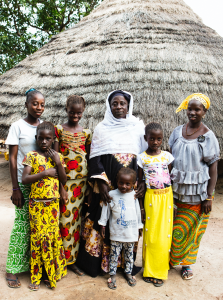
During the forums, there was much discussion on the central role of grandmothers in families and specifically in the lives of girls. Participants stated that any efforts to promote the well-being of girls and to discourage FGM should involve grandmothers first because they are responsible for preserving cultural norms and second because they have a close relationship with the cutters and hence, they have the greatest possibility of discouraging them from continuing this practice.
The combined results of the initial community assessment and forum dialogues provided substantive insight into communities’ priorities and concerns regarding the development and upbringing of children, especially of girls, and specific information on community views on FGM. Based on these results, as well as key principles from community development, adult education, anthropology, and community psychology, the GMP team identified a set of concepts and priorities that informed the design of the GHD intervention. These objectives included:
- to promote multiple facets of girls’ development related to positive cultural values and traditions, not only FGM, in order to increase both program relevance to communities and their involvement;
- to address both community and NGO concerns related to GHD;
- to promote positive cultural values and traditions while discouraging harmful ones;
- to relate program goals and activities to religious values and to include religious leaders;
- to build on existing community resources, or assets, in terms of experience, knowledge, and influential roles of community actors;
- to actively involve elders, including traditional and religious leaders on an ongoing basis;
- to strengthen communication between the generations e.g. elders, parents, and adolescents, and between men and women;
- to acknowledge and strengthen the role of grandmothers in families and communities as key transmitters of cultural values and as allies of young girls;
- to strengthen relationships between girls, mothers, and grandmothers;
- to strengthen the skills and commitment of community leaders, both male and female, and of three generations, to work collectively to promote positive change for girls in their communities;
- to use participatory adult learning approaches that catalyze reflection and community consensus-building for change.
Another critical factor related to the interface between the GHD program and communities was the development of respectful and ongoing relationships between GHD staff and community leaders and groups. Understanding of and sensitivity to local cultural values and traditions, and humility, were key parameters for the selection of DHF staff. In African societies, positive relationships are the basis for all interaction and collaboration.
Conceptually the GHD program draws on several disciplines namely, community psychology (especially the work of Foster-Fishman et al., 2007; Trickett et al., 2011; Hawe et al., 2009; Schensul & Trickett, 2009; O’Donnell & Tharp, 2011; Zimmerman et al., 2011); community development (especially Lasker & Weiss, 2003; Chaskin et al., 2001; Hughes et al., 2005); anthropology (Airhihenbuwa, 1995); adult education (Freire, 1972; Brookfield, 1984; White, 1999) and social work (Hartman & Laird, 1983).
Partnership with the Ministry of Education (MOE)
The GHD program is implemented in close collaboration with the District Education Office in Velingara. All of GMP’s objectives are related to priority concerns of the MOE related to children’s education and development, and specifically, that of girls, concerning girls’ education, child marriage, and teen pregnancy. GMP’s long-term objective is for the MOE to integrate the GHD intergenerational and grandmother-inclusive approach into their programs with communities.
Implementation of the Girls’ Holistic Development Program
A Holistic Approach for Systemic Change
GHD Model
The first funding for GHD came from World Vision and their initial concern was only FGM. However, based on the insights obtained during the Preparatory Phase regarding community concerns and priorities we proposed an approach to address girls’ needs holistically. The GHD circle, which has been widely used with communities, teachers and partner organizations, presents the key facets of girls’ development that are important to local communities, namely: moral, cultural, intellectual, spiritual, emotional, health, physical, and civic responsibility. Unfortunately, many national and international programs in support of girls ignore some other aspects of girls’ development that communities value related to their moral, spiritual and cultural development.
Program Goal and Objectives
The goal of the GHD program is to strengthen community capacity to promote girls’ health and well-being, with two general objectives:
- To strengthen communication and social cohesion within communities and families in order to promote systemic change in harmful social norms related to girls education, child marriage, FGM, teen pregnancy and FGM; and to
- To promote positive cultural roles, values, and practices that contribute to girls’ development and upbringing.
Implementation of the GHD program began in 2008 in the Velingara area in southern Senegal and has evolved over the past 12 years through iterative action research and learning process. It has involved testing, evaluation, revision, and expansion of the program in response to strong support and input from communities and local elected officials.
Holistic Focus on Girls’ Rights and Needs
Many international programs to improve the lives of girls address the four priority GHD issues (see objective no. 1 above), all widespread problems across Africa. The predominant pattern in such programs is to target girls, either primarily or solely, in a linear fashion based on the assumption that if they are empowered they will be able to catalyze change in families and communities. From the perspective of both anthropology and community psychology, in African societies, girls are embedded in family, community, and cultural systems, as visualized in the Onion Model (Aubel & Rychtarik, 2015). And those systems impose expectations on girls while at the same time providing them with critical support as they grow up and are faced with life’s challenges.
The Onion Model (Figure II) presents key facets of the context in which Senegalese girls are embedded and have several implications for the design of programs to support them: adolescent girls are not isolated and rarely make decisions on their own; various family members are involved in decisions affecting their wellbeing and options in life; grandmothers play a central role in the socialization of young girls, and grandmothers typically have more influence on men’s decision-making within the family than do mothers of young girls.

GHD aims to create an enabling environment around girls so that they can flourish. This is achieved by directly supporting girls while at the same time encouraging community-wide consensus building for the adoption of social norms and attitudes that are more supportive of girls. This two-pronged strategy is presented in the simplified Theory of Change in Diagram I below.
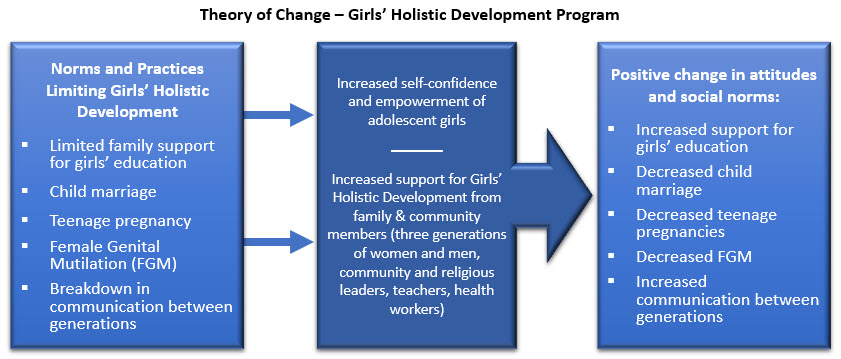
Building Communication Relationships
To promote community-wide change, key community actors must be involved. Also, strong communication relationships between them are the foundation for open dialogue and reflection on existing social norms and on alternative concepts and practices. In the initial assessment and forum dialogues, community members discussed the serious breakdown in communication between generations that exists in virtually all communities.
The following quote from a community elder illustrates the importance of communication relationships and the situation that existed in many communities at the outset.
“Communication is the foundation of life for any group. Without communication and understanding, there will never be any development. Many interventions failed in our communities because there was not enough dialogue and understanding between people. As long as there is a conflict or the absence of communication, the community will not progress.”
Diallo, Community Headman
Involvement of Community Leaders
A prerequisite for the success of any effort to improve community life is the existence of committed leadership, strong relationships between leaders and other community members, and a sense of solidarity often referred to as social cohesion. In light of the role and influence of both formal and informal community leaders, the GHD activities primarily target leaders of three generations (elders, adults, and adolescents), male and female, as well as recognized traditional leaders.
Building on Cultural and Religious Roles and Values
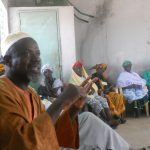
In all communities, there are leaders whose roles are determined by cultural and religious values and structures, and they have moral authority and influence on the attitudes of other community members. In the Velingara area, more than 98% of the population is Muslim. Traditional leaders and local Imams share responsibility for ensuring the well-being of their communities. In each community where the GHD program was launched, the GMP team first identified and established rapport with local formal and informal leaders.
A very erudite and respected imam, Oustaz Balde (in the photo on left ), has been a key resource for the GHD program. He has participated in many key activities and he is able to articulate the need to create a bridge between “traditional” cultural and religious values and more “modern” ideas related to various aspects of GHD including girls’ education and FGM.
“Through a participatory approach that encouraged communication between people, the GHD program has reinforced the sense of celebration among community members and acceptance of those with different opinions. Before, there was a real breakdown in communication between neighbors, within families, and between generations. GHD has encouraged introspection and self-critique. It seems that GHD has brought about an incredible reconciliation between the generations who now accept each other, understand each other, and are more tolerant of each other.”
Oustaz Balde, Imam, Velingara
Program Components
Change through Culture Process of Change
For designing any community change strategy there are two fundamental concepts, iterated in both community psychology and community development regarding the importance of building social cohesion within communities and specifically between community leaders and groups; and adopting an asset-based approach in which existing social resources, e.g. elders, leaders of all ages, are identified and strengthened. In Diagram II below, key elements in the Change through Culture process of change are laid out with both of those concepts (in the first column) along with the initial weaknesses in the cultural and community context (second column) identified during the Preparatory Phase.

Community Dialogue for Consensus-Building for Change
In order to promote community-wide change, a Community Dialogue for Consensus-Building approach was developed to involve various community actors in a series of participatory activities to elicit discussion on different facets of GHD. The objective of these activities was to catalyze dialogue and reflection, primarily between formal and informal leaders of both sexes and of three generations, first, to develop a consensus regarding the need for change, for example, to abandon child marriage, and second, to collectively decide on actions to be taken to promote change in existing norms and practices.
In light of the initially weak communication relationships in all communities where GHD has been introduced, an initial and ongoing priority in the GHD program is to strengthen those relationships in two ways: first, to strengthen existing relationships within communities, for example, between girls and grandmothers, and second, to encourage the creation of new communication relationships for example, between fathers and adolescent daughters. The objective is to create a synergistic effect through discussions of the same GHD issues by different community groups that can lead to a community-wide consensus on actions to be taken to promote GHD.
The core elements of the GHD program are a series of dialogical activities that involve different categories and combinations of community actors, of three generations, of both sexes, traditional and religious leaders, teachers, and local health workers. In all of these activities, grandmothers are key actors. Along with other community members, they participate in dialogue and debate, and their involvement strengthens their capacity and commitment to lead positive change.
These key activities are briefly described below in terms of its purpose and participants.
1) Intergenerational Forums
This is the foundational activity in GHD. Participants include leaders of both sexes and of 3 generations, traditional and religious leaders, teachers, and local health workers. The two-day forums build solidarity between participants through a series of carefully designed small and large group exercises, all involving dialogue, problem-solving, and consensus-building. Key topics addressed include the 4 priority GHD issues, intergenerational communication, cultural values, and identity.
“The intergenerational forums are very important as they help to re-establish dialogue between elders, parents, and youth. In the recent past, elders and adults didn’t listen to young people’s ideas and underestimated them. Thanks to the forums there is now more communication between older and younger community members.”
Grandmother Leader
“The forums have increased women’s confidence in themselves. Before, they didn’t dare express themselves in front of men. During community meetings, only men were allowed to speak. But now men know that women also have good ideas and encourage them to speak up.”
Young mother
“Before there was not enough discussion between men and women in families. It was a problem that separated them and was the root of frequent misunderstandings and arguments. The intergenerational forums have helped to solve this problem.”
Young adolescent boy
“We never before had the opportunity to sit all together and discuss like this although it is the best way to promote the development of our community elder leaders”
2) Days of Praise of Grandmothers
The purpose of these events is to celebrate grandmothers’ role and commitment to promoting the wellbeing of children, especially girls. Participants in these one-day gatherings include grandmother leaders from 8 surrounding communities, traditional and religious leaders, local musicians, local elected officials, and teachers.
Songs of Praise of Grandmothers are used during these events and provide relaxed interludes of singing and dancing.
These special days of recognition of grandmothers reflect the ideas of psychologist, Carl Rogers, on Unconditional Positive Regard (1980). The concept is that when GMs are recognized and their self-confidence is reinforced, they will be more open to revisiting their existing attitudes and practices. The following quotes reflect community attitudes toward these events.
“This is a very important day because we are here to honor the grandmothers who are the teachers of young couples and of children. Before this project, the grandmothers were practically dead in the village and now they have been revived. It is since the grandmothers have resumed their role that teen pregnancies have greatly decreased.”
Mamadou, Village Elder
3) GM Leadership Training
GMP realized that in all communities there are natural grandmother leaders who are recognized by other community members for their dynamism and selfless commitment to promoting community well-being. Through discussions with grandmother groups, five natural grandmother leaders were identified in each community to participate in the under-the-tree GM Leadership Training. The objectives of the training were to: increase GMs’ knowledge of adolescence, improve their communication with girls, and to empower them to act collectively to promote and protect girls, building on their status and authority at family and community levels. The training lasted for 8 days, divided into 4 two-day modules conducted over a period of 6 months.
Four months after the leadership training was completed, individual in-depth interviews were conducted with 40 grandmother leaders to assess the outcomes of the training Analysis of interview responses revealed three key results:
- Strengthened relationships between grandmothers,
- Strengthened relationships between girls, mothers, and grandmothers, thereby constituting a source of power and influence to protect and promote girls’ rights and well-being in a culturally consonant way, and
- Strengthened relationships between grandmothers and other influential community actors.
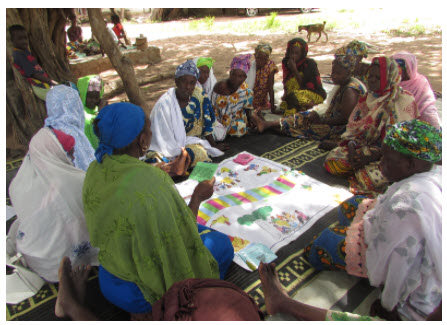
“Since we participated in the grandmother leadership training, the relationship between us grandmothers has changed. Now there is a permanent dialogue between us. Whenever one person has an idea of what we should do regarding our girls, we get together to discuss. Since the training, the relationships and communication between us have been strengthened”.
Grandmother Leader
“Thanks to these training sessions, I have become more confident. I no longer hesitate when there is something that needs to be said or done. I no longer bow my head when speaking before a group of men.
Grandmother Leader
“Before we used to scold our granddaughters all the time and they were rather afraid of us. Through the training, we realized that that is not a good way to communicate with them. Now we talk softly to the young girls and they listen to our advice with regards to sexuality and other things.”
Village headman’s wife
4) Teacher workshops on “Integrating Positive Cultural Values into Schools” (IPCVS)
Many families do not have a strong motivation to send their children to school nor to let them stay in school for many years. A major reason for families’ reticence is that schools do not teach cultural values that are important to communities. In 2019 one of the priorities defined in the Ministry of Education’s five-year plan was to expand the teaching of cultural values in schools. In partnership with the District Education Office in Velingara GMP developed the Integrating Positive Cultural Values (IPCV) into Schools strategy. The initial activity in launching this strategy in schools consists of teacher workshops to increase teachers’ commitment to developing children’s knowledge of cultural values and traditions, in addition to the “modern” knowledge inscribed in the official curriculum, and to strengthen their relationships with communities. Local education officials are very supportive of this strategy as suggested in the following quote.
“These workshops support national priorities to increase children’s understanding and adoption of positive cultural values and to strengthen teacher-community relationships and communication”.
Amadou Lamine Wade, District Education Office Director
5) Grandmother-Teacher Workshops
Both teachers and grandmothers have frequent contact with and influence on children, and specifically on girls related to their education, child marriage, and teen pregnancy. However, in most communities, direct contact between teachers and grandmothers is very limited, and teachers often have a sense of superiority over illiterate grandmothers while these guardians of tradition suffer from a sense of inferiority toward well-educated teachers. The objective of these workshops is to strengthen relationships between teachers and grandmothers in order to increase their collaboration to promote both the teaching of positive cultural values in schools and in the community and to promote GHD. These innovative workshops are strongly supported by education officials, teachers, and grandmothers.
“Teachers alone do not have all of the knowledge that children need to learn. They also need to learn about positive cultural values and behavior. I don’t know of anyone else in the community who is more knowledgeable regarding the values that children should acquire. That is what justifies the presence of the grandmothers here today. And increased communication between teachers and grandmothers is very beneficial to children, especially to girls.”
Mr. Ba, Supervisor, District Education Office
“We are honored to have been invited to participate in this workshop along with teachers and school directors. We are going to work together with the teachers to encourage all children, those in school and not, to learn the values that are important in our culture.”
Maimouna, Grandmother
An important component of the IPCVS strategy is the participation of grandmothers in classrooms to facilitate value education sessions with children. This further contributes to strengthening relationships between schools and communities.
6) Under-the-Tree Sessions with Grandmothers, Mothers, and Girls
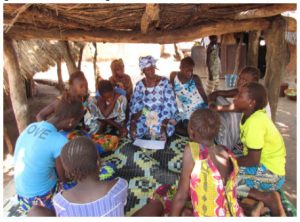
Building on grandmothers’ traditional advisory role with adolescent girls, it is primarily grandmothers and girls who are involved in these sessions, but also mothers. A major activity in GHD is frequent participatory dialogue and learning sessions to strengthen communication between the generations and discussion of topics related to girls’ education and development. A variety of activities using stories, songs, games, and discussion pictures are used to elicit dialogue and increase understanding between the generations.
7) All Women Forums
An activity that was initiated in 2019, these two-day forums: strengthen communication between girls, mothers, GMs, and female teachers; promote collective empowerment of girls; and catalyze dialogue on concerns to both girls and their mothers and GMs. During these forums, a variety of participatory exercises encourage girls to express their feelings, concerns, and ambitions related to school and life beyond and encourage mothers and grandmothers to listen to, empathize with and encourage girls. This activity aims to strengthen the collective sense of responsibility that mothers and grandmothers have not only for their own daughters but for all girls in their communities.
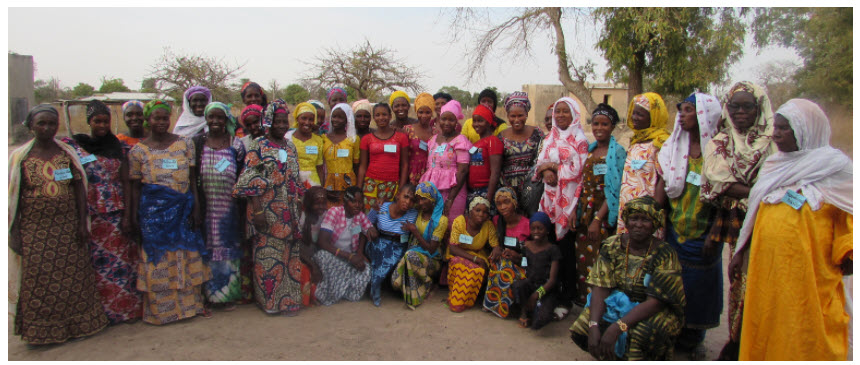
Below are several comments by adolescent girls who participated in under-the-tree sessions with grandmothers and who also attended the All Women Forums.
“There is a change in our relationships with our grandmothers. Before, we preferred to go to dancing parties or to watch television instead of being with them. Now, we spend more time with the grandmothers, listening to their stories that teach us about important values”.
Adolescent girl
”We are closer to our grandmothers now. If we have questions related to sexuality we can discuss them with our grandmothers, more easily than with our mothers. Now we are comfortable talking to the grandmothers”.
Adolescent girl
8) Days of Dialogue and Solidarity
In all communities where GHD is implemented, elders play an important role in families and communities and they have a big influence on the social norms that define acceptable attitudes related to many aspects of life. Many facets of GHD, e.g. girls’ education and FGM, are influenced by the attitudes of the elders, specifically the elder men in each family, traditional community male leaders, Imams, and grandmothers. These are the community actors who are involved in the Days of Dialogue and Solidarity. The purpose of this activity is to elicit reflection by the elders from several adjacent communities on the role that they can play to promote GHD. As with other GHD activities, the idea is to strengthen the knowledge and the role played by existing community actors. In other terms, the elders constitute a community resource, or asset, that can be strengthened to promote the programs’ objectives. In each of these events, participants articulate their plans for actions they can take in their respective communities.
“This meeting has been very useful because it has allowed us to discuss important issues with others from our same village and with people from other villages. In our community we plan to organize meetings with all generations, to discuss what we can do together to prevent child marriage and FGM.”
Moussa, Village Headman
“These meetings are very beneficial because they encourage communication and understanding between us. During this meeting, I realized that FGM is not recommended by Islam. Many Imams were present and none of them support the practice”.
Cissé, Grandmother Leader
Referring back to Figure 3, I think that you can see how the various dialogical activities organized by the GHD Program created a synergy between the different community actors by promoting community-wide discussion of various issues related to GHD.
GHD Theory of Change and Program Results
At the outset of the GHD Program in 2008, a Theory of Change (TOC) was developed with the GMP team in Senegal. However, during the ten years of development of GHD, there was a conscious effort to encourage a process of continuous learning. To support this learning process, a series of evaluations and studies were conducted by external researchers, in collaboration with GMP staff for two purposes: 1) to understand communities’ attitudes and response to the GHD Program, and 2) to identify changes that may have come about as a result of the GHD program. Several external evaluations looked broadly at program results. The additional studies focused on: family decision-making related to child marriage; the process of abandonment of FGM/C in some communities; communication between the generations; changes in gender roles and the status of women; the effects of the grandmother leadership training; and the relationship between the culturally-grounded program and community engagement in it. And in 2019, the Institute of Reproductive Health (IRH) at Georgetown University, in collaboration with the University of Dakar, conducted extensive quantitative and qualitative research to evaluate the results of the GHD program.
Based on the conclusions of the various evaluations and studies, and the GMP team’s lived experience with communities carrying out the program, we revised the Theory of Change to reflect what has happened as a result of implementing the program.
Diagram IV (below) synthesizes the relationship between the GHD program and its intermediary and long-term results. We can also refer to this sequence of events as the pathway to change.
As the diagram indicates, the implementation of the GHD Program was initiated through the development of respectful relationships between GMP facilitators and community actors. Those relationships were the foundation for a series of dialogical activities addressing GHD. Intermediary results of the GHD Program are observed first, in terms of increased communication and social cohesion between generations and between the sexes. Strengthening those communication relationships supported the subsequent changes at the community level and with schools in support of girls, and of children more broadly. The combination of those changes has supported change within families, related to family roles and communication which ultimately has had a positive impact on girls. These multi-level results are contributing to long-term changes which are taking place related to increased community capacity to collectively promote GHD in an ongoing fashion and changes in social norms to support girls related to their education, marriage, teen pregnancy and FGM/C.
Georgetown University Evaluation of the GHD Program
The most extensive research on the GHD Program was carried out by the Institute of Reproductive Health (IRH) in the context of the USAID-funded PASSAGES project. Between 2017 and 2019, IRH provided support for several smaller studies (mentioned above) and for the larger Realist Evaluation conducted in collaboration with the University of Cheikh Anta Diop in Senegal. Key conclusions of the two-part IRH research are presented below. They are (1) The GHD program created safe spaces for dialogue and consensus building (2) it provided a space for community discussions, (3) decision making in families and communities became more inclusive and gender equitable, (4) the program reestablished grandmothers as traditional family counselors and advocates for girls in Senegal, (5) relationships between grandmothers and girls was strengthened and girls improved their confidence levels, (6) grandmothers demonstrated more openness and support for girls’ education, (7) social changes were visible, and (8) programs should equally focus on family members and communities.
Key conclusions of the Georgetown University of GMP’s Girls Holistic Development Program
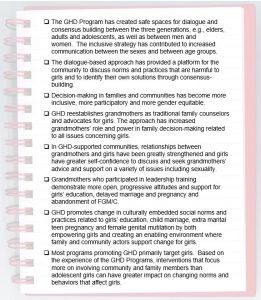
Lessons Learned from the Girls’ Holistic Development Program
Based on the various studies and experience of the GHD team working in southern Senegal, a number of lessons are identified that have wide application for other programs addressing GHD across Africa and elsewhere in the Global South where societies are hierarchically structured, elders are respected and have influence, and where grandmothers play a role in socializing and supporting adolescent girls.
- In all African communities, elders have status and power over younger generations and determine the social norms that structure family and community life. When an approach based on respect and dialogue is used, they are not automatically opposed to change.
- When programs respect and build on cultural and religious roles and values that communities cherish, community actors are more receptive and more engaged. The opposite is also true.
- In non-western cultural contexts, where extended family networks are stronger, grandmothers play a role in all aspects of the upbringing and development of children, especially girls. Using an assets-based approach, programs should acknowledge and build on this cultural resource.
- Families are concerned about all facets of girls’ upbringing and development. Communities are more receptive to programs that address various facets of girls’ development, rather than single-issue strategies.
- Community involvement in programs is greater when programs supporting girls’ development address issues that are of concern to communities in addition to the priority concerns of development organizations.
- Communication between three generations (elders, adults, and adolescents) should be strengthened in order to promote harmonious change within family and community systems rather than creating conflict between generations with differing opinions.
- Both formal and informal leaders, of all three generations and both sexes, should be involved in all efforts to promote change in communities. Given their influence with their respective peer groups, they are powerful gatekeepers who can either support or block new ideas and behaviors.
- Communication and education methods used with community groups should be based on adult education methods which elicit critical reflection among community actors rather than on persuasion and messages disseminated to passive beneficiaries, or audiences, to convince them to adopt expert-identified solutions.
- Communities are more open and engaged in programs that adopt an asset-based approach where positive roles, values, and practices are encouraged and reinforced while harmful ones are discouraged. This lesson builds on Carl Rogers’ concept of Unconditional Positive Regard.
- In any program, it is important to determine at the outset what the roles and influence are of different family and community actors in order to involve all categories of people who influence or who could influence the issue being addressed.
Conclusion
The GHD Program was primarily initiated through the development of respectful relationships between GMP facilitators and community actors. These relationships served as a foundation for a series of dialogical activities addressing GHD. Intermediary results of the GHD Program were observed first, in terms of increased communication and social cohesion between generations and between the sexes. This work made us even more aware of an asset- versus deficit-based approach, no matter the context.
From Theory to Practice Reflections and Questions
- As you think through this case study, identify one or two ways it can be challenging to work alongside different generations of individuals and families.
- We all have differences of opinions and worldviews on social issues facing our world. What are your thoughts on how we advance social and racial justice internationally when worldviews diverge regarding what is culturally appropriate?
- We believe that all work involving social and racial justice should begin with engaging in introspection and self-awareness processes. What are some ways you have engaged in self-reflection concerning working across groups who have different customs and beliefs from your own? Share at least two ways you will do so moving forward.
- The Girls’ Holistic Development Program was developed and implemented in Senegal. We believe that the concepts and methods used in Senegal are relevant to other African settings and that many are relevant to other contexts in the non-western world and also to communities in the global north.
References
Airhihenbuwa, C. O. (1995). Health and culture: Beyond the western paradigm. Sage Publications, Inc.
Aubel, J. & Rychtarik, A. (2015) Focus on Family and Culture. Grandmother Project – Change through Culture for TOPS project funded by USAID, Washington D.C.
Brookfield, S. D. (1991) Developing critical thinkers: Challenging adults to explore alternative ways of thinking and acting. Jossey-Bass.
Chaskin, R.J., Brown, P. Venkatesh, S., & Vidal, A. (2001) Building community capacity. Aldine De Gruyer.
Foster-Fishman, P. G., Nowell, B., & Yang, H. (2007). Putting the system back into systems change: A framework for understanding and changing organizational and community systems. American Journal of Community Psychology 39, 197-215. https://doi.org/10.1007/s10464-007-9109-0
Freire, P. (1970) Pedagogy of the oppressed. Continuum.
Hartman, A. & Laird, J. (1983). Family-centered social work practice. Free Press.
Hawe, P., Shiell, A. & Riley, T. (2009). Theorizing interventions as events in systems. American Journal of Community Psychology, 43, 267-276. https://doi.org/10.1007/s10464-009-9229-9
Institute of Reproductive Health, Georgetown University (2019) Grandmother Project – Change through Culture: Program for Girls’ Holistic Development: Qualitative Research Report. Washington D.C., for USAID.
Institute of Reproductive Health, Georgetown University (2019) Grandmother Project – Change through Culture: Program for Girls’ Holistic Development: Quantitative Research Report. Washington D.C., for USAID.
Lasker, R.D. & Weiss, E.S. (2003). Broadening participation in community problem solving: A multidisciplinary model to support collaborative practice and research. Journal of Urban Health. 80 (1) 14-60.
O’Donnell, C. R. & R.G. Tharp (2011), Integrating cultural community psychology: Activity settings and the shared meanings of intersubjectivity. American Journal of Community Psychology. https://doi.org/10.1007/s10464-011-9434-1
Rogers, C. (1980). A way of being. Houghton Mifflin.
Schensul, J. J. & Trickett, E. (2009). Introduction to multi-level community based culturally situated interventions. American Journal of Community Psychology 43, 232-240. DOI 10.1007/s10464-009-9238-8
Trickett, E. et al. (2011). Advancing the science of community-level interventions. American Journal of Public Health 101(8),1410-1419. https://doi.org/10.2105/AJPH.2010.300113
White, S.A. (1999). The art of facilitating participation. Sage Publications, Inc.
Note
*All photographs are courtesy of Dr. Judi Aubel


Feedback/Errata